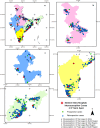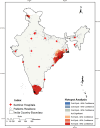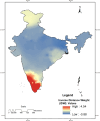Geospatial methodology for determining the regional prevalence of hospital-reported childhood intussusception in patients from India
- PMID: 38509132
- PMCID: PMC10954623
- DOI: 10.1038/s41598-024-57187-8
Geospatial methodology for determining the regional prevalence of hospital-reported childhood intussusception in patients from India
Abstract
Both developed and developing countries carry a large burden of pediatric intussusception. Sentinel site surveillance-based studies have highlighted the difference in the regional incidence of intussusception. The objectives of this manuscript were to geospatially map the locations of hospital-confirmed childhood intussusception cases reported from sentinel hospitals, identify clustering and dispersion, and reveal the potential causes of the underlying pattern. Geospatial analysis revealed positive clustering patterns, i.e., a Moran's I of 0.071 at a statistically significant (p value < 0.0010) Z score of 16.14 for the intussusception cases across India (cases mapped n = 2221), with 14 hotspots in two states (Kerala = 6 and Tamil Nadu = 8) at the 95% CI. Granular analysis indicated that 67% of the reported cases resided < 50 km from the sentinel hospitals, and the average travel distance to the sentinel hospital from the patient residence was calculated as 47 km (CI 95% min 1 km-max 378 km). Easy access and facility referral preferences were identified as the main causes of the existing clustering pattern of the disease. We recommend designing community-based surveillance studies to improve the understanding of the prevalence and regional epidemiological burden of the disease.
Keywords: Children; GIS; Geospatial; Hospital proximity; India; Intussusception; Moran’s I; Spatial clustering.
© 2024. The Author(s).
Conflict of interest statement
The authors declare no competing interests.
Figures




References
MeSH terms
Grants and funding
LinkOut - more resources
Full Text Sources

